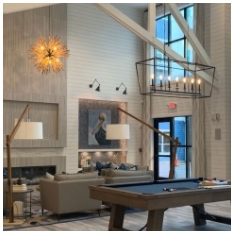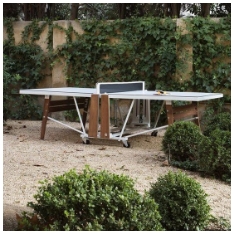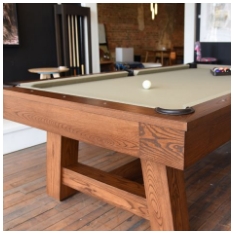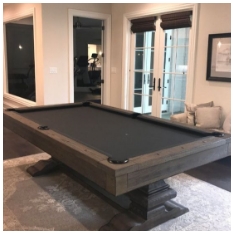If you’ve ever played a game of pool, you’ve likely noticed the smooth, durable fabric that covers the table. This fabric plays a crucial role in the game, affecting the speed and accuracy of the balls.This article will answer that question and provide an in-depth look at the materials used, their characteristics, and how to care for them.
The Name of Pool Table Fabric
The fabric covering a pool table is commonly referred to as "pool table cloth" or "felt," though these terms can sometimes be misleading. While "felt" is a term widely used, the actual material used on most modern pool tables is not traditional felt, but a woven wool or wool-nylon blend. The most precise term for pool table fabric is "baize," which is a specific type of woven cloth traditionally used for covering gaming tables.

Types of Pool Table Fabric
Woolen Cloth
Woolen cloth, also known as napped cloth, is one of the most common types of pool table fabric. This type of cloth has a fuzzy surface created by the nap, or the raised fibers on the fabric. The nap can affect the speed and direction of the balls, often resulting in a slower game compared to other types of cloth. Woolen cloth is commonly used in recreational and home pool tables due to its affordability and durability.
Worsted Cloth
Worsted cloth, often referred to as "speed cloth," is another popular option for pool tables, especially in professional settings. This type of cloth is made from tightly woven wool fibers that are combed to remove short strands, resulting in a smooth, flat surface. The lack of nap on worsted cloth allows for faster ball movement and more consistent play. This is why it is often the preferred choice for tournaments and competitive play.
Polyester and Nylon Blends
Some pool tables, particularly those intended for casual or outdoor use, may feature polyester or nylon blend fabrics. These materials are less expensive than wool-based cloths and are often more resistant to environmental factors such as moisture and sunlight. However, they may not offer the same level of playability as woolen or worsted cloths, as they can be less smooth and may wear out more quickly.
Characteristics of Pool Table Fabric
Durability
One of the most important characteristics of pool table fabric is its durability. The fabric must withstand the constant friction of balls rolling across its surface, as well as the impact of cue sticks and the occasional mishaps during play. Wool-based cloths are particularly valued for their durability, with worsted cloth being the most resilient option due to its tightly woven structure.
Speed and Control
The type of fabric used on a pool table significantly influences the speed of the game. Woolen cloth, with its nap, tends to slow down the balls, making it better suited for casual play. Worsted cloth, on the other hand, provides a faster and more precise playing experience, which is why it is often used in professional settings. Players looking for a faster game with more control over ball movement may prefer worsted cloth.
Aesthetic Appeal
Pool table fabric also contributes to the overall appearance of the table. Available in a variety of colors, from traditional green to blue, red, and even custom hues, the fabric can be chosen to match the decor of the room or the branding of a venue. The color of the cloth does not affect the playability, but it does impact the visual appeal of the table.
Caring for Pool Table Fabric
Proper maintenance of pool table fabric is essential for preserving its quality and ensuring a long-lasting playing surface. Here are some key tips for caring for your pool table cloth:
Regular Cleaning
Dust, chalk, and other debris can accumulate on the surface of the pool table fabric, affecting the playability and appearance. Regularly brushing the cloth with a special pool table brush helps remove these particles. It’s important to brush in straight lines from one end of the table to the other, following the direction of the nap (if present) to avoid damaging the fabric.
Avoiding Spills and Stains
Spills can be particularly damaging to pool table fabric, especially if they are not cleaned up immediately. Liquids can seep into the cloth, causing stains and potentially weakening the material. If a spill occurs, blot the area with a clean, dry cloth and avoid rubbing, as this can spread the stain and damage the fibers. For stubborn stains, it may be necessary to use a specialized cleaner designed for pool table cloth.
Controlling the Environment
The environment in which the pool table is placed can also impact the longevity of the fabric. Humidity and temperature fluctuations can cause the cloth to expand or contract, leading to a less stable playing surface. It’s best to keep the table in a climate-controlled room and avoid placing it near windows or direct sunlight, which can cause fading and deterioration over time.
Conclusion
In summary, the fabric used on pool tables is most accurately called "baize," though terms like "felt" and "pool table cloth" are commonly used. There are different types of pool table fabric, including woolen cloth, worsted cloth, and synthetic blends, each with its own characteristics that affect gameplay. Proper care and maintenance are crucial for preserving the quality of the fabric and ensuring a smooth, enjoyable playing experience. Whether you’re a casual player or a seasoned professional, understanding the fabric on your pool table can enhance your game and extend the life of your table.





